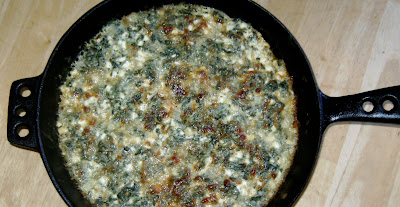

We've been working on our recipe for
dosas--savory fermented rice and dal pancakes--for years now. Sometimes the batter came out well, but we had trouble getting it to rise consistently. Our eureka moment about dosas happened
in India last winter, watching the cooking instructor pour perfectly bubbly batter onto a hot griddle. It's hot in India! That's why the batter ferments so perfectly and gets so bubbly. So, if we could just get our dosa batter to India temperatures at home, we could make real Indian dosas that stay together and fold nicely. Success!
Making dosa batter takes a few tries to master, so don't bust this one out for that big first date until you've practiced a few times. You can also use dosa batter for
uttapam, which thicker and sturdier, like a personal pizza. We've provided recipes for both here. If you want to make some of each, make the uttapam while the batter is still thick, then thin it down for dosas.
1 cup parboiled rice (boil 1 cup rice in a large pot of water for 5 minutes; drain.)
2 cups raw rice
1 cup urad dal
2 teaspoons fenugreek seeds
1 teaspoon salt
This works equally well with brown rice, white rice, or a combo.
Combine everything, except the salt, in a large bowl with enough lukewarm water to cover and allow to soak overnight. Drain, reserving the liquids. Blend until you have a consistency like thick pancake batter, adding only enough of the soaking water to lubricate your blender. Pour into a bowl that leaves room for the batter to double in size.
Cover with a towel and place somewhere warm. The batter likes to be 85-95 degrees Fahrenheit. In Kerala, that's just room temperature. Here in Berkeley, we use our dehydrator, which has adjustable temperature settings. We've heard of other creative solutions like leaving it in the oven on low, with the door propped open, or near a radiator. Within eight hours, the dough will double and fill with tiny bubbles. You should detect a pleasantly sour, yeasty smell. If your dough doesn't rise after the first eight hours, you don't have to give up! Try adjusting your heat source and give it another eight hours. Once your batter has risen, mix in the salt and proceed with one of the following recipes.
 Uttapam
Uttapam1 batch of batter, risen
coconut oil for frying (Coconut oil is solid in cold weather, but will quickly become liquid if you leave the bottle somewhere warm. Liquid oil is much easier to drizzle!)
Choice of toppings:
chopped red onion
finely minced green chili
chopped cilantro leaves
chopped tomato
chopped nuts
minced fresh herbs
cubed feta (not traditional, but quite delicious!)
Heat a well-seasoned cast iron or crepe pan over medium-high heat, and coat the pan lightly with oil. When the oil is as hot as possible without smoking, pour about a 1/4 cup of batter into the center of the pan. Quickly toss on some toppings, plus a little drizzle of oil around the edges.
When the pancake looks firm enough to flip (3-5 minutes), gently loosen it with a clean, greased metal spatula. Flip it over and cook for another 3-5 minutes. Carefully scrape away any bits that stuck to the pan and add a little more oil. When the oil is hot, begin your next pancake. Serve warm, with a
selection of curries and chutneys.
 Dosas
Dosas1 batch of batter, risen
coconut oil for frying
Stir a little water into your batter for a crepe-like consistency. Heat a well-seasoned cast iron or crepe pan over medium-high heat, and coat the pan lightly with coconut oil. When the oil is as hot as possible without smoking, pour about a 1/4 cup of batter into the center of the pan, spreading it around in a spiral pattern with the back of your ladle. It should be thin, with some lacy areas, but no large holes. Pour a fine drizzle of oil around the edges to help them get crispy.
Cook for about 3 minutes, or until the dosa easily lifts from the pan. If your dosa is nice and thin, you won't need to fry on both sides -- just transfer to a plate, fill with a
thick curry and serve. If your dosa came out a little too thick, there's no harm in flipping it over to make sure it's cooked on both sides.
















